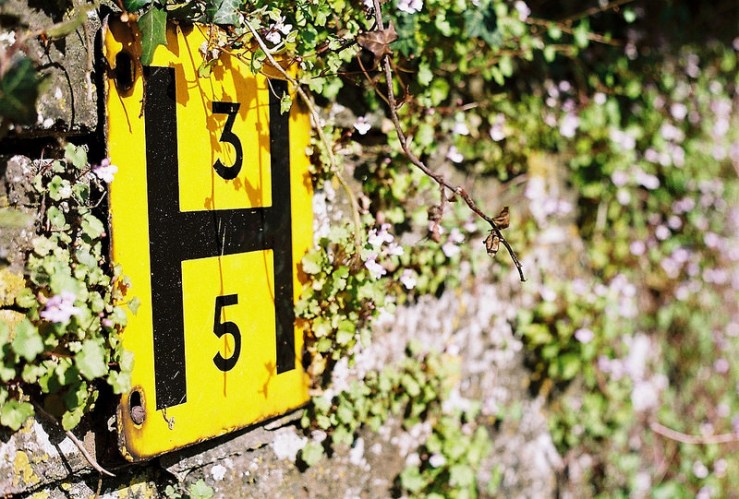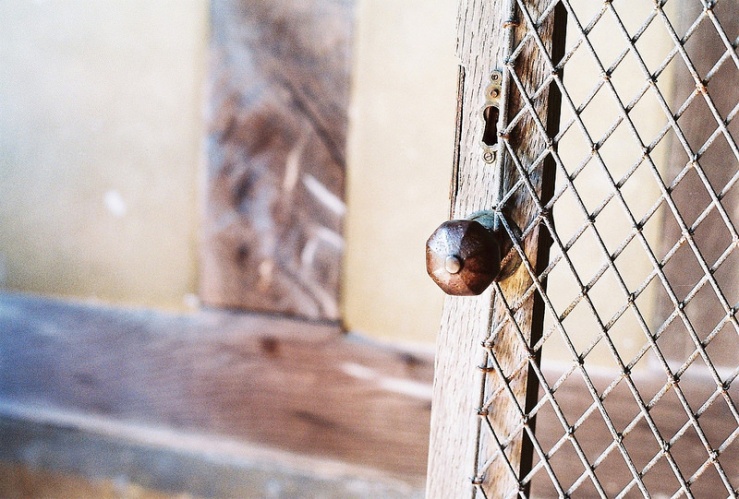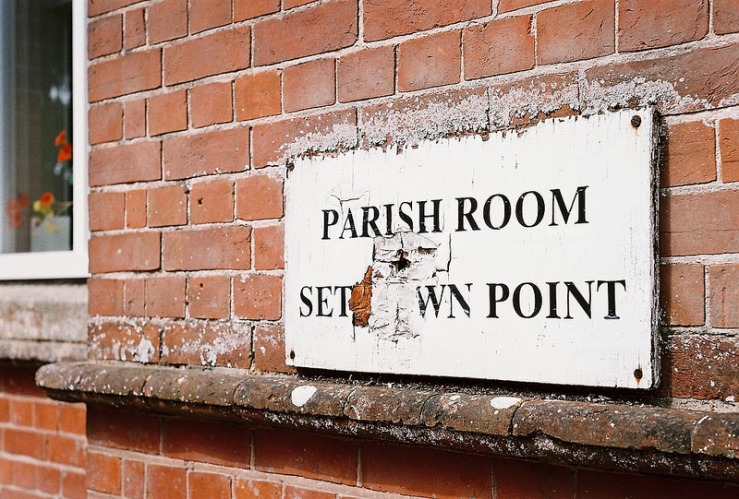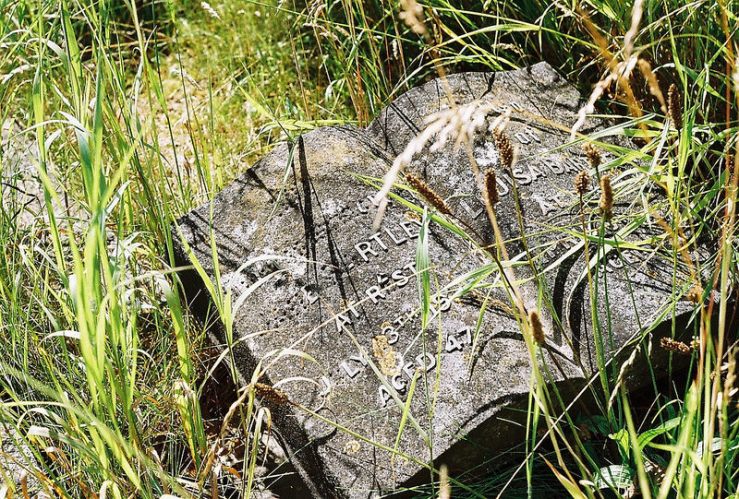
Whilst many of my favourite cameras are electronic and require batteries to do anything, not just meter (hello Contax 139 Quartz, 159MM and 167MT!), I own half a dozen others that are fully mechanical and either require a battery just for the meter, or have no meter at all.
A couple of years ago I wouldn’t have thought it possible that I could use a camera without a light meter.
How would I have even the faintest clue how to set so many crucial manual controls – focus, aperture and shutter speed – to ensure I got any photographs at all, let alone reasonably exposed ones?
You’ve probably felt a similar anxiety and gone running back to the comforting security of Programmed AutoExposure modes.

Then, maybe a year ago I ventured out using a compact digital camera on aperture priority mode as a light meter.
I’d set the ISO of the digital camera to the same as the film I was using, the aperture of the digital to the same as my film camera (a Zorki-4 or Fed-3 at the time), then read the shutter speed from the screen when I pointed it at what I wanted to photograph. Then I changed the shutter speed on the film camera to the same as the digital, composed and shot.
This worked, and gave me reasonable results, but it felt very long winded going through this process for every single shot.
Plus it was clumsy trying to switch between two cameras and not drop one or both of them.
More importantly, this complication fundamentally rallied against the simple joy and escapism from the modern world I gain from using vintage cameras.

Later still I used a Light Meter app on my phone, which was quicker, more portable and more flexible. And gave great results.
But again, I didn’t like metering for every shot, or flicking between the phone and camera. Plus once again using a new digital device to meter kind of spoiled that timeless mood and experience of using vintage all mechanical and battery less cameras.
Being a fan of simplicity and minimalism, I finally decided to take the plunge, ditch the light meter(s) and try metering on my own, based on the Sunny 16 rule.

I’ve simplified and adapted along the way, so here is my current method for metering with as little interruption to that wonderful flow of using vintage cameras as possible…
- Set the camera’s default shutter speed.For the Sunny 16 method, you set the shutter speed to the reciprocal of the ISO you want to shoot the film at. If it’s fresh film this might be box speed, but I generally shoot expired colour negative film and like to lean towards overexposing. So for ISO200 film, where I would shoot it at ISO125 in a camera with its own meter, I set the shutter speed to 1/125s.
- Decide and set the default aperture.I use the Sunny 16 rule as a starting point, but living in England we never really enjoy Sunny 16 strength sunshine. So I change it to Sunny 11. In other words, in the brightest conditions when it’s sunny and there’s not a cloud in the sky, set the aperture to f/11. If it’s hazy sun, use f/8, overcast f/5.6, heavy overcast f/4.
- Compose, focus, shoot.I think you know this part already.
If/ when the lighting conditions change as you’re shooting, for example a sudden descent of cloud cover, or you move into a very shady area from a bright sunny one, just change your aperture accordingly, as outlined in step 2 above.

A way of simplifying this method even further is to make an assessment of the average light conditions at the start, add a stop maybe (I always lean towards over exposure, more on that below), “set and forget” your camera, and get on with enjoying shooting.
So for a day which is slightly overcast, with ISO200 film you want to shoot at ISO125, set the shutter speed to 1/125, and the aperture to f/5.6 (two stops under the min f/11 for bright sunny conditions). Then put the settings out of your mind and go and enjoy photographing.
(I would estimate that on such a day I will shoot 80% or more of the shots on the roll of film at those default settings of 1/125s and f/5.6 without touching either dial.)

Sometimes you might want more creative control than staying at one shutter speed and aperture.
So here are some simple tips, using our default starting point above of 1/125s and f/5.6 on a slightly cloudy day.
If you want greater depth of field – Decrease the aperture to f/8 or f/11 and take the shutter speed down to 1/60s or 1/30s to compensate.
If you want shallow depth of field – Increase your aperture to f/4, f/2.8 or f/2, and adjust the shutter speed in line – 1/250s, 1/500s or 1/1000s respectively.
If you want to freeze movement, like people walking – Set your shutter speed a stop or two faster than your default 1/125s, to 1/250s or 1/500s, and open up the aperture accordingly to f/4 or f/2.8.
If you want some ghostly motion blur – Take the shutter speed the other way – 1/60s, 1/30s and 1/15s will need an aperture decrease from your default f/5.6 to f/8, f/11 or f/16 respectively.

It turns out that shooting without a meter is not that hard after all.
A crucial reason for this is the latitude of the film I use. What latitude means is the amount you can over or under expose the film, and still get usable results.
Most consumer colour negative films I use like AgfaPhoto Vista Plus 200 (rebranded FujiColor C200), Kodak Color Plus 200, Ferranis Solaris 200 and Fuji Superia 100 have a very forgiving latitude.
You can see what it is exactly by looking at the DX code on the film canister and using a guide like this.

But a general rule, most of these consumer colour negative films can be under exposed by one stop, and over exposed by three stops (let’s abbreviate this to -1 / +3).
This is partly why I lean (fairly heavily) towards overexposing.
In practice, what this -1 / +3 latitude means, is that if at 1/125s the optimum aperture is f/11, I can still get a very usable photograph if I shoot at an aperture of f/16 (-1), f/8 (+1), f/5.6 (+2) or f/4 (+3).
Put another way, this same scene can be shot with very reasonable results at 1/125s and any aperture between f/4 and f/16!
That’s very forgiving indeed.
Or, if you were to fix the aperture for this same scene at f/11, and the optimum shutter speed was 1/125s, it means you could still get decent pictures using a shutter speed anywhere between 1/250s (-1) and 1/15s (+3).

With the basic starting point taken from using Sunny 16 (or in my case Sunny 11) and the confidence the -1/+3 latitude of colour negative film gives me, I can set my camera up before I start shooting, then virtually forget the settings and enjoy the pure, simple pleasure of using a camera in the same way it was used a generation or two or three before me.
And for me, photography doesn’t really get much more special or rewarding than that.
What is your experience of shooting without a light meter? Let me know below.
If you’ve never tried it before I strongly urge to grab some colour negative film and get out there. You’ll be amazed at what you can do without a battery, needle or LED in sight, and just how it enriches the whole photographic experience.
Thanks for reading. Please share this post with others you feel will enjoy it too.


Great article. I shoot exactly the same way on my Hasselblad. With the interlock on the v lenses, keeping the exposure, but achieving different “creative effects” is actually really easy.
Thanks Jim. I remember one of the things I liked most about using a few Zenit SLRs with selenium meters I’ve had is the exposure dial. You line up the static needle with the active light meter needle, then take a reading off the exposure dial which gives you all the possible combinations of aperture and shutter speed for that correct exposure at a glance.
Even if you ignore the needles and the lightmeter, the dial is very handy to use shooting Sunny 11 (the Zenits are fully mechanical so this is possible) so you can start with your default of say 1/125s and f/8 and quickly see what other aperture and shutter speed combos give the same exposure, without having to count up and downs the stops and numbers in your head.
Thanks for the encouragement. I shoot Sunny 16 pretty much only when I have no other choice. I am sure that if I just practiced it, I’d become good at it.
Jim, what do you think stops you using Sunny 16 more often? What part of it do you struggle with? With colour negative film and leaning towards overexposure, I’m sure you’ll get a decent exposure at least 90% of the time.
I think it’s my perfectionist streak. I want the shot to be right in camera.
It’s funny: I recently shot a whole roll of Tri-X at one stop under, by accident, and rescued 90% of the shots in Photoshop. So it’s not that big of a deal to get exposure a little wrong, especially on most color negative film. I shoot miles of Fujicolor 200 and that stuff is probably enormously forgiving.
Jim, I don’t even use Photoshop, I just use the scans straight from the CD from the lab.
I realised long ago that one of the joys of photography for me is escaping everything and getting out into nature. It seemed to completely defeat the point to spend two or three hours scanning and tweaking images for every hour I spent actually using the camera. So I started to just go with the CD scans, warts and all, and mostly they come out pretty good.
I think it helps that I came into film through very “lo-fi” cameras, where the imperfections were a part of the charm. My first film camera was a gift – a Holga 120N. Then shortly after my first 35mm film camera was a Lomo Smena 8M.
I enjoyed (and still do) experimenting with expired film, cross processing, light leaks, DIY redscale and so on, and with all of these techniques, perfection is far from the end goal! So even though now I use much more “precise” and technically capable kit, I don’t seek perfection.
Yes FujiColor C200 is the film I’ve shot more than anything else, in the guise of C200 itself, and rebranded as AgfaPhoto Vista Plus 200 and Tudorcolor XLX 200. I’m pretty sure its latitude is 1-/+3, and certainly from experience using it without metering it’s been very reliable and forgiving.
As I understand it b/w film is less forgiving. You can check the manufacturer’s recommended latitude via the DX code as it shows in the link above – https://en.wikipedia.org/wiki/DX_encoding
Slide film also needs far more precise exposure, so I probably wouldn’t try exposing that without any external assistance!
And of course the general rule for any film tends to be “expose for the shadows” and lean towards overexposure. Underexposing very quickly gives washed out and sometimes horrible results. All good reason to overexpose a stop or two or three rather than aiming for a perfect exposure and risk underexposing.
I hope you try some Sunny 16 adventures again soon.
Interesting and good article as ever Dan. The latitude of modern film is so forgiving and there is a school of though you should be over exposing by a stop anyway (I wonder if that’s why you find f/11 more on target – even here in Not so sunny Scotland on really bright days my meter can hit the f/16 target)
Worth having a read at
http://petapixel.com/2015/08/10/how-much-can-you-overexpose-negative-film-have-a-look/
And
http://canadianfilmlab.com/2014/04/24/film-stock-and-exposure-comparisons-kodak-portra-and-fuji/
Thanks Alan for your comments and the links.
At the level I’m at (maybe “enthusiastic amateur” would be a good description), I’m not too concerned about having perfect exposures. This method works well enough for me, I like probably 95% of the results, in terms of exposure.
If I was going for greater precision, or if I shot a lot in low light, or if I used a lot of slide and black and white film with much less latitude, or if I made large prints of my photographs, I may not be so keen on using this kind of “Guess-O-Matic” approach. But with my cameras, with colour negative film, and for my requirements, it works really well, and it’s very liberating shooting with no reliance on battery power!
[…] How I Shoot Film Simply Without A Light Meter […]
[…] and experience of the Sunny 16 rule to aid with this approach too, in the same way I use it to shoot without a lightmeter in fully manual […]
[…] M42 bodies remain in my collection – an Asahi Spotmatic F and a Fujica ST701. I shoot Sunny 11 with both of them, and they’re […]
[…] mount. So I wanted a compact, classy, aperture priority body to use them on, when I wasn’t guessing Sunny 11 exposures using my all manual Fujica ST701 or Pentax Spotmatic F bodies. A simple adapter is available that […]
[…] How I Shoot Film Simply Without A Light Meter […]
Great blog Dan. I’m a new returnee to 35mm photography myself and have just bought a beautiful Voigtlander Vito B (100% mechanical, fully manual). The iPhone app I used for light metering (Lux) is handy, but I agree that it is a bit of a nuisance to have to get it out before every shot. I love your simplified sunny 16 rule so will be trying that out on the second roll of film through it. Getting out and shooting without faffing about is so much more appealing. Looking forward to getting my first set of prints back now…
good write up, pretty much the way I do.
best,
[…] How I Shoot Film Simply Without A Light Meter […]
[…] How I Shoot Film Simply Without A Light Meter […]
[…] is because, in my experience, the less forgiving exposure latitude of digital sensors compared with colour film say which often had -1 to +3 stops exposure latitude, means I get exposure wrong way more […]
[…] When I look at 35hunter‘s stats for, say, last week, the most viewed post is one I wrote in the summer of 2016 – How I Shoot Film Simply Without A Light Meter. […]
[…] In fact for as long as I can remember, the most read post on 35hunter in the stats month after month is one I wrote two and half years ago – How I Shoot Film Simply Without A Light Meter. […]
[…] them. My most read post on 35hunter every month since the two years plus I wrote it is about shooting film without a light meter. If I had just tried to sequel after sequel of that post, I wouldn’t have written any of the […]
[…] How I Shoot Film Simply Without A Light Meter (Jul 2016) – My simple guide to using film cameras without light meters has remained the most viewed post pretty much every month since I wrote it. […]
Fantastic information!
Thanks Trey. Have you shot film without using a light meter yourself?
[…] the top post is once again How I Shoot Film Simply Without A Light Meter, which has been the top post every month since I wrote it two and a half years […]
I have had a similar experience. My ‘proper’ first film cameras in the 1980s both had a working lightmeter – Yashica TL Electro SLR and Nikon FE. I really enjoyed using them. I then used to shoot some compacts and 110 cameras and sort of missed out – but they were small enough to carry around. Later when I moved onto a digital Nikon D60 I started to explore again but found myself relying on shutter priority.
Now I have a digital Olympus Pen F. – love it and some times shoot some vintage lenses with it. But more and more I buy and use vintage cameras – with or without working light meters. When I go out for a photo walk I take a few readings in different directions with an App light meter so that I get a general feeling for how light it is. Then I use my judgement (and sunny 16). If I get a few wrong I use Lightroom to improve the scanned image. But to be honest I am better than I thought I would be.
I found that in my experiments too Richard, with the latitude of colour negative film especially (typically -1/+3 stops) I tried to just aim for one stop overexposed and let the latitude absorb any errors, and most of the time the exposure was good enough.
MUCH harder trying to do this with digital cameras!
Hi!
I bought a Pentax spotmatic a few years ago with the intention of getting into more manual photography (I’ve just been using point and shoot 35mm cameras) but I haven’t been using it because the light meter is broken and I don’t have previous experience with shooting slr. This seems like a really approachable method to shoot without a light meter.
If I’m shooting with 400 iso film, would you recommend setting my camera iso to lower than 400 and shutter speed at 1/500 or setting iso to 400 and shooting at 1/250 (or a different combination)?
Thank you 🙂
Thanks for reading and your comments Nix!
I think for me a big part of my “success” with shooting without a light meter is the practice I had with a light meter before (either in a camera, or using a separate phone/camera to meter) and more than this, the latitude of the film.
You mention ISO400 film, which is it you plan to use? I would look at the spec of the film and see what the exposure latitude is.
Most consumer films I use to use were ISO100 or 200 with +3/-1 exposure latitude. So they were very forgiving, especially on the over exposure side.
Also, under exposed pictures on film look far worse than over exposed film (washed out colours, often a purple tinge, loads more grain), so always lean towards over exposing for this reason too.
Even if you start each photo session with a phone or digital camera to get an initial reading of the light conditions, then use that as a base camp for using your manual film camera, after a few times you’ll get used to settings needed.
Also the time of day, where you are in the world, the weather/lighting all make quite a difference, so again getting an initial reading with a reliable meter, even for a just a few times at the start of each roll of film, will help longer term in learning what works best for you and your specific set up. I’d also say maybe wait for good lighting conditions, and consistent weather helps greatly. Far too many times I’ve gone on knowing the light is poor or difficult (perhaps very bright sunlight and being in and out of shade) and regretted the results. Good light is the one most important ingredient in giving yourself the best chance of good exposures.
Hope this helps!
Totally concur with you James.
That old adage; ‘shoot for shadows, and develop for the highlights’ came about in the film days just for that reason. Muddy and grainy shadows is soul destroying when you pull your negative strip from the tank.
Regarding metering, most mortals will need a base reading to start the day shooting. I have an old Seikonic 308 that I take out with me. When I start the session, I take one reading in the sunlight, and turn around to take a reading in the shade of my body. That gives me 2 readings I use during the day. Full light and one for the shadows. Then it’s down to muscle memory.
I found the best way to get into the swing of shooting without a meter is to pick a film speed, and stick with that ASA. I started off with 400, and only shot that for the longest time. Actually, I am back shooting most of my images on that stock speed now.
It is best to keep at least one of the exposure triangle as a constant. Then it’s just a case of deciding if you want for freeze the action, meaning shooting around a 500th. That will now also stay constant and all I will change is the f-stop. And make sure I am using my base readings to set the aperture to start off with.
I personally shoot zone focusing, and shoot at f8… THAT old adage, f8 and be there. Of course that is dependent on full light or shade. All it now takes is moving the shutter speed from say 125 (or 60 in full shadow) and 500 (or 1000 in full sunlight)
And if I see the light is changing, a take a quick reading with the Seikonic to reset my base exposures. It is totally freeing and lets you enjoy the whole picture taking process. Yes it does slow you down somewhat, but I feel having 2 rolls of 36 exposures to look through is far me to my liking that sifting through 1000 very similar digital images that got shot that day. And most people still end up with one or 2 keepers for any shooting outing, whether film or digital.
I’m glad to hear someone as seasoned as you still uses a light meter to find a base level. That’s a great idea taking one reading into the sun and another with your back to the sun, then having these two as your edge parameters.
Fixing two of the three factors of exposure makes it easiest, as you say, I completely agree. So using the same ISO film, and fixing your aperture, means you then only have to adjust shutter speed within probably a maximum four of five stop range defined by those initial two light meter readings, if the light is changing and/or you’re moving in and out of shadow.
As I said in the post, using a film with -1/+3 latitude and leaning towards over exposing means you can usually get away with adjusting the shutter speed across an even smaller range of stops, and in consistent weather/light could probably just leave it on one that was a stop or two over exposed compared with what your light meter recommends.
Always good to have your input.